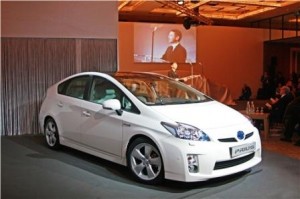With Toyota announcing nearly 3.5 million recalls since just the beginning of this year – on top of a record 4 million in 2009 – the embattled Japanese maker’s top executive issued his first official comment, in the form of an apology, today.
“I am deeply sorry,” declared Akio Toyoda, president and CEO and heir to the founding family of the Toyota Motor Co. Toyoda spoke with the Japanese network NHK after leaving the annual summit of world leaders held in Davos, Switzerland.
“Truly we think of our customers as a priority and we guarantee their safety,” the executive said, according to a translation, but Toyoda cautioned that he could not explain the source of a series of problems that have led Toyota to announce the recall of 7.6 million vehicles since just last October due to safety problems that could result in runaway cars, an issue also known as sudden, or unexpected, acceleration.
Even as the executive apologized, there were growing signs that further problems could be in store for the Japanese giant.
As Ken Zino, editor of TheDetroitBureau.com and World Auto Reports first reported, on December 24th, there are mounting concerns that 2010 Toyota Prius models may experience unexpected problems with brakes that can suddenly release when the vehicle hits a bump or pothole. In recent days, as word of the problem has begun to spread, TheDetroitBureau has received calls and letters from a number of additional owners, including Wisconsin’s Jill Krahn, who says her third-generation Prius has experienced unintended brake release on a number of occasions.
“I become almost airborne (feels like it) going over a manhole cover, or when there is a slight separation in the pavement,” Krahn writes, echoing the experience of others TheDetroitBureau.com has spoken with. “The last time this happened here in Wisconsin on dry pavement early December where I came within inches of the car in front of me when trying to brake.”
The National Highway Traffic Safety Administration has been tracking reports of unintended brake failure and a source reports the numbers are likely to increase sharply as the national spotlight falls on Toyota.
A senior source at the company, asking not to be identified, suggested the problem could be the result of “aggressive” antilock braking systems used on the dual-function brakes on the Prius. Initially, the hybrid’s brakes are designed to regenerate energy, which is then stored in the vehicle’s batteries. In more aggressive maneuvers, Prius will switch to a conventional hydraulic brake mode. The system requires extensive use of sensors and computer controls to operate smoothly and effectively. A minor software glitch could cause serious repurcussions.
Software problems could be at least part of the problem with Toyota models already involved in an expanding pair of recalls, one announced last October, another earlier this month.
Toyota officials, including Executive Vice President Bob Carter, initially and rather angrily insisted that the “only” cause for the company’s problems lay with loose carpet mats that could come loose and “entrap” a vehicle’s gas pedal. But the recall announced last week, which led Toyota to halt sales of eight models and shut production at five plants, was blamed on “sticky accelerators.”
It remains unclear precisely what that means, as it could point to mechanical linkages, electronic controllers or both. But a Toyota dealer confirmed to one of the team members of TheDetroitBureau.com that the carmaker has made quiet no-charge repairs, sometimes called “secret warranties,” to a number of vehicles, in recent years, which involved electronic sensors and controllers.
That was echoed by Canada’s CBC News, which interviewed Sean Kane, president of Massachusetts-based Safety Research and Strategies, Inc. “In the past,” he told the radio network’s “As It Happens” program, “Toyota has actually done technical bulletins to reflash the algorithms in their control units to prevent unintended acceleration incidents.”
Keane specifically noted a bulletin covering the 2002 and 2003 Camry sedan, calling for a “reflash” if customers complained of unintended acceleration when traveling between 38 and 42 mph.
“I think what we’re going to see is additional recalls,” said the safety expert.
Meanwhile, the repurcussions of the Toyota safety crisis continue to mount. More automakers, a list now including Ford, General Motors and Hyundai, are taking aim at the Japanese maker with targeted incentives. And it appears a Congressional hearing could be called to look into the safety issues plaguing the automaker.
The automaker plans to fight back with a full-page ad it will place in newspapers in 25 cities, on Sunday, the Wall Street Journal reported, explaining how it plans to handle the latest of its recalls.
But the damage to the company’s image could be difficult to repair, warned Dave Sargent, head of automotive research at J.D. Power and Associates, “especially,” he said, “if the problems spread to other models.
In a particularly painful move, the influential Consumer Reports magazine has suspended its normal “buy” recommendations on the eight models involved in the latest recall. CR has had a policy of routinely recommending Toyota products, based on its long history of quality and reliability – though the publication did briefly lift its endorsement of several models, including the Tundra pickup, two years ago, because of a spate of quality problems.

